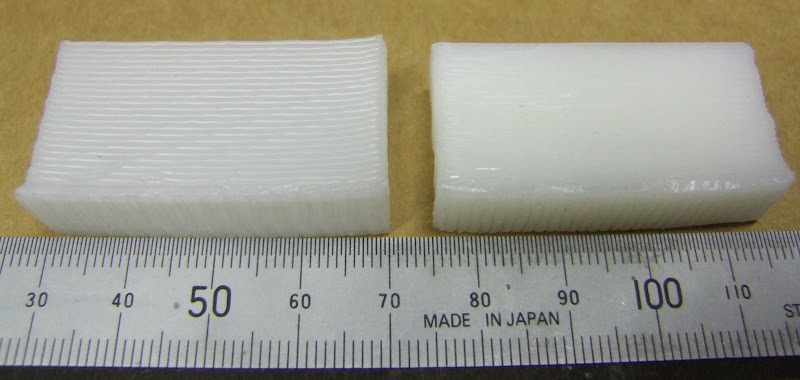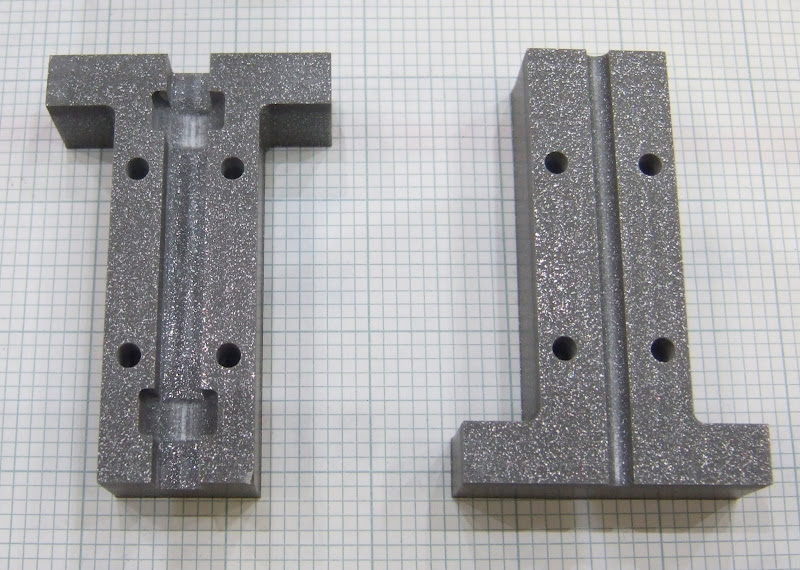So my extruder died at the beginning of the month. I have been busy with other things so I have only just got round to thinking about rebuilding it. Here is a list of things that failed :-
I got my extruder working in mid
August. At the end of
September it ejected its PTFE barrel from the clamp, breaking the heater wires. This is a common problem and stems from the fact that PTFE has the lowest coefficient of friction of any known solid material. I tightened it further and it didn't slip out again. However, when I came to dismantling it I noticed that the end that was in the clamp has been compressed by about 0.3mm. The 3.2mm drill that I made the hole with is now quite a tight fit so the hole may have shrunk slightly. I will drill it out to 3.3mm because some of my 3mm HDPE filament is slightly more than 3.2mm where it is a bit oval.
One curious thing is that it now looks to have a thread in the entry hole.

I am struggling to explain this. The only way I can think it may have happened is as follows :-
The filament has a thread cut into one side by the drive screw. Before I added my feed
spool the filament used to rotate as it went through the extruder and had a thread cut all the way round. Perhaps it transfered its thread to the PTFE, which is quite soft.
The final failure mode was the nozzle jumping a couple of threads and leaking molten HDPE. It rammed the nozzle through the object being made and damaged the bed underneath.

The bottom end of the PTFE barrel has swollen by about 0.3mm.
PTFE is known to creep, i.e. when subjected to a prolonged force it very slowly flows. It has no memory so it does not spring back when the pressure is removed. I think this is why the top of the barrel shrank and the bottom expanded. There is a lot of pressure in the barrel and it is close to PTFE's maximum operating temperature. PTFE melts at 327°C but it starts to degrade at 260°C. I have been running at 240°C which is a bit too close for comfort.
My barrel, at 12mm, is smaller than the current recommendation which is 16mm. This may have contributed to the failure.
The recommended solution is to fit a pipe clip, but I didn't have one small enough, so I pressed a short section of 15mm OD pipe over the end, which is a tight fit. It had the desired effect. When I first made the barrel the thread was a snug fit. When I dismantled it I noticed it had become quite sloppy. With the ring of metal in place it is now a tight fit. I will use some plumber's PTFE tape to seal it as well.

The other thing that was on the point of failing was the flexible drive shaft. Strands started breaking and the more that broke the more it flexed, so it was a kind of avalanche effect. I estimate that the shaft had rotated about 100,000 times so the flexing backwards and forwards must have caused metal fatigue. I probably have the most mileage on this part of anybody so far so it could be a sign of a design flaw. There are a couple of problems with my implementation which certainly won't have helped.
The first is that I used some 2.5mm cable I had to hand rather than the 3mm recommended. It doesn't seem like a big difference but I think the rotary strength is at least a cube law which would make my cable roughly half as strong. It was left over from a garage door installation but I don't think I have any worries there as 100,000 flexes is about 75 years use!
The other contributory factor is that the bearing lands on my drive shaft are a little bit eccentric. This stems from the fact that my watchmaker's lathe is not really big enough for this work. Fundamentally the hole through the headstock is not big enough to take the 5mm threaded rod.
Each time the shaft rotates it opens and closes the pump halves a little. This makes a big torque variation over a revolution because of the strong springs holding it closed. That caused the cable to wind up and unwind a little each revolution. It actually modulated the filament width and gave the objects a basket weave appearance. Here is a good example :-

I bought some new parts from
www.bitsfrombytes.com, which wasn't an option when I first made the extruder.

That will allow me to give the flexible drive a fair test. If it proves to be unreliable then I will switch to direct drive. I found out from the core team that it is not required for any of the polymers currently used, only things like
Field's metal.
Another thing that was starting to fail was the J-B Weld holding the heater wire to the nozzle. It is supposed to be rated to 315°C but it had started to crumble with my extruder running at 240C. The other problem I had with my J-B Weld is that it does not cure in the specified time at room temperature. I have to bake it to make it strong. I emailed J-B Weld but got no response apart from an automated reply.
David commented on my last post suggesting
Thermosteel ,which is good for 1300ºC,
so I will try that next. A couple of the core team use BBQ paint which handles 600°C so I will try that as well.


















































